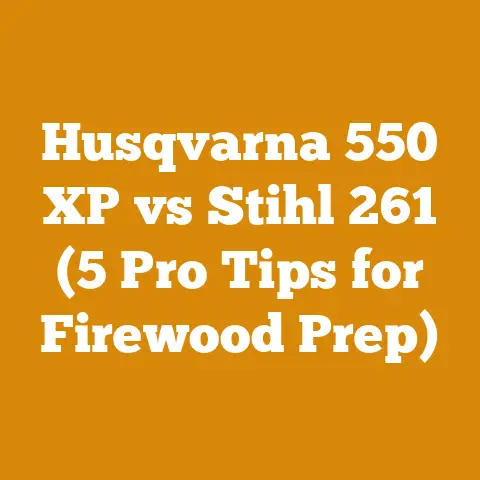Concrete Blocks for Fireplace (5 Pro Tips to Prevent Flue Cracks)
Let’s talk about fireplaces.
Specifically, fireplaces built with concrete blocks.
While they might seem like a budget-friendly option, I’ve seen firsthand how quickly things can go wrong, leading to cracked flues and a whole lot of headaches.
That’s why I believe a carefully considered, professionally installed fireplace, even if it costs more upfront, is almost always the best option for long-term safety and peace of mind.
But, if you’re set on using concrete blocks, let’s make sure you do it right.
Concrete Blocks for Fireplace (5 Pro Tips to Prevent Flue Cracks)
I’m going to share my insights on how to minimize the risk of flue cracks when using concrete blocks for fireplace construction.
I’ve spent years around wood stoves, fireplaces, and all things related to heating with wood, and I’ve learned that a little knowledge can go a long way in preventing costly and dangerous mistakes.
1. Understanding the Thermal Properties of Concrete Blocks
Concrete blocks and fire don’t always play nicely together.
Unlike firebrick, which is specifically designed to withstand extreme temperatures, concrete blocks are more susceptible to thermal shock.
This means rapid temperature changes can cause them to expand and contract unevenly, leading to cracks.
It’s critical to understand this fundamental difference.
The Science Behind Thermal Expansion
- Concrete’s Thermal Expansion: The coefficient of thermal expansion for concrete typically ranges from 7 to 13 x 10^-6 /°C.
This means that for every degree Celsius increase in temperature, concrete will expand by 7 to 13 millionths of its original length.
While this seems small, the repeated heating and cooling cycles in a fireplace can accumulate over time, leading to stress fractures. - Firebrick vs.
Concrete: Firebrick is specifically formulated to have a much lower thermal expansion coefficient and greater resistance to thermal shock.
This is why it’s the preferred material for the firebox of a fireplace.
My Experience with Thermal Shock
I once helped a friend build a pizza oven using concrete blocks for the outer structure.
We lined the inside with firebrick, but we didn’t properly insulate between the firebrick and the concrete.
After just a few uses, we started to see hairline cracks in the concrete blocks near the firebox.
The heat was transferring through the firebrick and causing the concrete to expand at a different rate, leading to stress.
This taught me a valuable lesson about the importance of proper insulation and material selection.
Mitigating Thermal Shock: Key Steps
To minimize thermal shock when using concrete blocks in a fireplace, I recommend the following:
- Use Firebrick for the Firebox: This is non-negotiable.
The firebox, which is the area directly exposed to the flames, must be constructed with firebrick. - Insulate Between Firebrick and Concrete: Use a layer of high-temperature insulation, such as ceramic fiber blanket, between the firebrick and the concrete blocks.
This will help to reduce the amount of heat that transfers to the concrete. - Allow for Expansion Joints: Incorporate small expansion joints in the concrete block structure to allow for movement.
These joints can be filled with a flexible sealant. - Slow and Steady Fires: Avoid building extremely hot fires quickly.
Gradually increase the temperature to allow the materials to heat up evenly.
Takeaway: Understanding the thermal properties of concrete and firebrick is crucial for preventing flue cracks.
Always use firebrick for the firebox, insulate properly, and allow for expansion.
2. Choosing the Right Type of Concrete Blocks
Not all concrete blocks are created equal.
Some are denser, some are stronger, and some are more resistant to heat than others.
Selecting the right type of block can significantly impact the longevity of your fireplace.
Understanding Concrete Block Grades
Concrete blocks are graded based on their compressive strength, which is measured in pounds per square inch (psi).
The higher the psi, the stronger the block.
For fireplace construction, I recommend using blocks with a minimum compressive strength of 2,000 psi.
- Standard Concrete Blocks: These typically have a compressive strength of 1,500 to 2,000 psi.
They are suitable for general construction purposes, but I wouldn’t recommend them for the firebox area of a fireplace. - High-Strength Concrete Blocks: These have a compressive strength of 2,500 psi or higher.
They are more durable and resistant to cracking, making them a better choice for fireplace construction, especially for areas near the firebox. - Lightweight Concrete Blocks: These are made with lightweight aggregates, making them easier to handle.
However, they are generally less strong and less resistant to heat than standard or high-strength blocks.
I would avoid using them in fireplace construction.
The Importance of Density
Density is another important factor to consider when choosing concrete blocks for a fireplace.
Denser blocks are generally more resistant to heat and cracking.
Look for blocks with a density of at least 120 pounds per cubic foot (pcf).
- How Density Affects Heat Resistance: Denser blocks have a higher thermal mass, meaning they can absorb more heat without experiencing significant temperature changes.
This helps to reduce the risk of thermal shock and cracking. - Checking Block Density: You can usually find the density information on the manufacturer’s website or on the block itself.
You can also estimate the density by weighing a block and measuring its dimensions.
My Experience with Block Selection
I once used lightweight concrete blocks to build a small outdoor fire pit.
I thought I could save some money and make the project easier by using lighter blocks.
However, after just a few fires, the blocks started to crumble and crack.
The lightweight blocks simply couldn’t withstand the heat.
I ended up having to tear down the fire pit and rebuild it with denser, high-strength blocks.
This experience taught me the importance of choosing the right type of block for the job.
Best Practices for Block Selection
To ensure you’re using the right type of concrete blocks for your fireplace, I recommend the following:
- Consult with a Structural Engineer: A structural engineer can assess your specific needs and recommend the appropriate type of block for your project.
- Check the Manufacturer’s Specifications: Always review the manufacturer’s specifications for the blocks you’re considering.
Pay attention to the compressive strength, density, and thermal resistance. - Choose High-Strength, Dense Blocks: Opt for blocks with a compressive strength of at least 2,000 psi and a density of at least 120 pcf.
- Avoid Lightweight Blocks: Do not use lightweight concrete blocks in fireplace construction.
Takeaway: Choosing the right type of concrete block is essential for the safety and longevity of your fireplace.
Opt for high-strength, dense blocks and consult with a structural engineer if necessary.
3. Proper Mortar Selection and Application
The mortar that holds your concrete blocks together is just as important as the blocks themselves.
Using the wrong type of mortar, or applying it incorrectly, can lead to cracks and structural instability.
I’ve seen firsthand how a seemingly minor mortar issue can quickly escalate into a major problem.
Understanding Mortar Types
Mortar is classified by type, based on its compressive strength and other properties.
The most common types of mortar are Type M, Type S, Type N, Type O, and Type K.
Each type has a different mix ratio of cement, lime, and sand.
- Type M Mortar: This is the strongest type of mortar, with a compressive strength of 2,500 psi or higher.
It’s typically used for load-bearing walls and foundations. - Type S Mortar: This is a high-strength mortar with a compressive strength of 1,800 psi or higher.
It’s commonly used for below-grade applications and areas subject to high winds or seismic activity. - Type N Mortar: This is a medium-strength mortar with a compressive strength of 750 psi or higher.
It’s suitable for general-purpose masonry work, such as non-load-bearing walls and chimneys. - Type O Mortar: This is a low-strength mortar with a compressive strength of 350 psi or higher.
It’s typically used for interior, non-load-bearing walls. - Type K Mortar: This is a very low-strength mortar with a compressive strength of 75 psi or higher.
It’s rarely used in modern construction.
Choosing the Right Mortar for Fireplace Construction
For fireplace construction, I recommend using Type S mortar.
It provides a good balance of strength, flexibility, and workability.
Type M mortar is also an option, but it can be more difficult to work with and may not be necessary for most residential fireplaces.
- Why Type S Mortar? Type S mortar is designed to withstand the stresses caused by temperature changes and moisture.
It also has good bonding properties, which helps to prevent cracks. - Avoid Type N Mortar: While Type N mortar is suitable for chimneys, I would avoid using it in the firebox area of a fireplace.
It’s not strong enough to withstand the extreme temperatures and stresses.
Proper Mortar Application Techniques
Even the best mortar won’t perform well if it’s not applied correctly.
Here are some tips for proper mortar application:
- Mix the Mortar According to the Manufacturer’s Instructions: Add the correct amount of water to the dry mortar mix and mix thoroughly until you achieve a smooth, workable consistency.
- Clean the Concrete Blocks: Before applying the mortar, make sure the concrete blocks are clean and free of dust, dirt, and debris.
- Dampen the Blocks: Lightly dampen the blocks with water before applying the mortar.
This will help the mortar to bond properly. - Apply a Full Bed of Mortar: Apply a full bed of mortar to the top of each block, ensuring that the entire surface is covered.
- Use a Trowel to Create a Smooth, Even Joint: Use a trowel to create a smooth, even joint between the blocks.
The joint should be about 3/8 inch thick. - Strike the Joints: After the mortar has set slightly, strike the joints with a jointing tool to create a neat, professional finish.
- Cure the Mortar Properly: Keep the mortar damp for at least 72 hours after it’s applied.
This will help it to cure properly and achieve its full strength.
My Mortar Mishap Story
I once rushed a fireplace project and didn’t properly mix the mortar.
I added too much water, which weakened the mortar and caused it to crumble.
After just a few months, I started to see cracks in the joints.
I had to chip out all the old mortar and re-mortar the entire fireplace.
This taught me the importance of taking the time to mix the mortar correctly and follow the manufacturer’s instructions.
Takeaway: Choosing the right type of mortar and applying it correctly are crucial for the structural integrity of your fireplace.
Use Type S mortar, mix it according to the manufacturer’s instructions, and follow proper application techniques.
4. Reinforcing the Structure
Reinforcing the concrete block structure of your fireplace can significantly increase its strength and resistance to cracking.
I always recommend adding reinforcement, especially in areas that are subject to high stress or temperature changes.
Types of Reinforcement
There are several ways to reinforce a concrete block fireplace, including:
- Rebar: Rebar (reinforcing bar) is a steel bar that is embedded in the mortar joints to provide additional strength.
It’s typically used in load-bearing walls and foundations. - Wire Mesh: Wire mesh is a grid of steel wires that is embedded in the mortar joints to provide additional tensile strength.
It’s often used in walls and floors. - Bond Beams: Bond beams are horizontal concrete beams that are reinforced with rebar.
They are typically used to tie together the walls of a structure and distribute loads evenly.
Reinforcing a Concrete Block Fireplace
For a concrete block fireplace, I recommend using a combination of rebar and wire mesh.
- Rebar Placement: Place vertical rebar in the corners of the fireplace and at intervals of no more than 4 feet along the walls.
The rebar should extend from the foundation to the top of the fireplace.
Also, place horizontal rebar in the mortar joints at intervals of no more than 2 feet. - Wire Mesh Placement: Embed wire mesh in the mortar joints between the concrete blocks.
The wire mesh should overlap at least 6 inches at the joints. - Bond Beam: If your fireplace is particularly large or complex, consider adding a bond beam at the top of the structure to tie the walls together.
My Reinforcement Experience
I once helped build a large outdoor fireplace that was located on a sloping lot.
We knew that the fireplace would be subject to a lot of stress, so we took extra care to reinforce the structure.
We used a lot of rebar and wire mesh, and we also added a bond beam at the top of the fireplace.
The fireplace has been standing for over 10 years now, and it’s still in perfect condition.
I attribute its longevity to the thorough reinforcement we used.
Best Practices for Reinforcement
To ensure you’re reinforcing your concrete block fireplace properly, I recommend the following:
- Consult with a Structural Engineer: A structural engineer can assess your specific needs and recommend the appropriate type and amount of reinforcement for your project.
- Use High-Quality Materials: Use only high-quality rebar and wire mesh that meet ASTM standards.
- Follow Proper Placement Techniques: Make sure the rebar and wire mesh are properly embedded in the mortar joints and that they overlap at the joints.
- Protect the Rebar from Corrosion: Apply a corrosion-resistant coating to the rebar to protect it from rust.
Takeaway: Reinforcing the concrete block structure of your fireplace can significantly increase its strength and resistance to cracking.
Use a combination of rebar and wire mesh, and consult with a structural engineer if necessary.
5. Proper Flue Liner Installation
The flue liner is a critical component of any fireplace.
It’s a tube that runs from the firebox to the top of the chimney and is designed to contain the combustion gases and prevent them from escaping into the house.
A properly installed flue liner is essential for safety and efficiency.
Understanding Flue Liner Types
There are several types of flue liners available, including:
- Clay Tile Liners: These are the most common type of flue liner.
They are made of fire clay and are relatively inexpensive.
However, they are also susceptible to cracking and can be difficult to install. - Metal Liners: These are made of stainless steel or aluminum and are more durable than clay tile liners.
They are also easier to install and can be used in a wider range of applications. - Cast-in-Place Liners: These are made of a special type of concrete that is poured into the chimney to create a seamless liner.
They are very durable and can be used to repair damaged chimneys.
Choosing the Right Flue Liner for a Concrete Block Fireplace
For a concrete block fireplace, I recommend using a stainless steel flue liner.
They are more durable than clay tile liners and are less likely to crack.
They are also easier to install, especially in a concrete block chimney.
- Why Stainless Steel? Stainless steel flue liners are resistant to corrosion and can withstand the high temperatures of a fireplace.
They are also flexible, which allows them to accommodate movement in the chimney. - Avoid Clay Tile Liners: While clay tile liners are less expensive, I would avoid using them in a concrete block fireplace.
They are more likely to crack, especially if the chimney is not properly constructed.
Proper Flue Liner Installation Techniques
Installing a flue liner can be a challenging task, especially if you’re not familiar with the process.
Here are some tips for proper flue liner installation:
- Measure the Chimney: Measure the height and width of the chimney to determine the correct size of flue liner.
- Clean the Chimney: Clean the chimney thoroughly to remove any debris, such as soot, creosote, and loose mortar.
- Insulate the Liner: Wrap the flue liner with insulation to protect it from temperature changes and to improve the efficiency of the fireplace.
- Install the Liner: Carefully lower the flue liner into the chimney, making sure it is centered and aligned properly.
- Seal the Liner: Seal the top and bottom of the flue liner with a high-temperature sealant to prevent leaks.
- Have the Installation Inspected: Have the flue liner installation inspected by a qualified chimney sweep or building inspector to ensure it meets local codes and standards.
My Flue Liner Fiasco
I once tried to install a clay tile flue liner in an old chimney.
I thought I could save some money by using clay tiles instead of stainless steel.
However, the tiles were very difficult to work with, and I ended up cracking several of them during installation.
I also had a hard time sealing the joints between the tiles.
After just a few fires, I started to notice smoke leaking into the house.
I had to remove the clay tile liner and replace it with a stainless steel liner.
This experience taught me that it’s always worth it to invest in high-quality materials and proper installation techniques.
Takeaway: Proper flue liner installation is essential for the safety and efficiency of your fireplace.
Use a stainless steel flue liner, insulate it properly, and have the installation inspected by a qualified professional.
By following these five pro tips, you can significantly reduce the risk of flue cracks when using concrete blocks for fireplace construction.
Remember, safety should always be your top priority.
If you’re not comfortable with any aspect of the project, don’t hesitate to consult with a qualified professional.
A well-built and properly maintained fireplace can provide years of warmth and enjoyment, but a poorly constructed one can be a safety hazard.
Take your time, do your research, and build it right.
I hope my experience helps you on your fireplace building journey.






